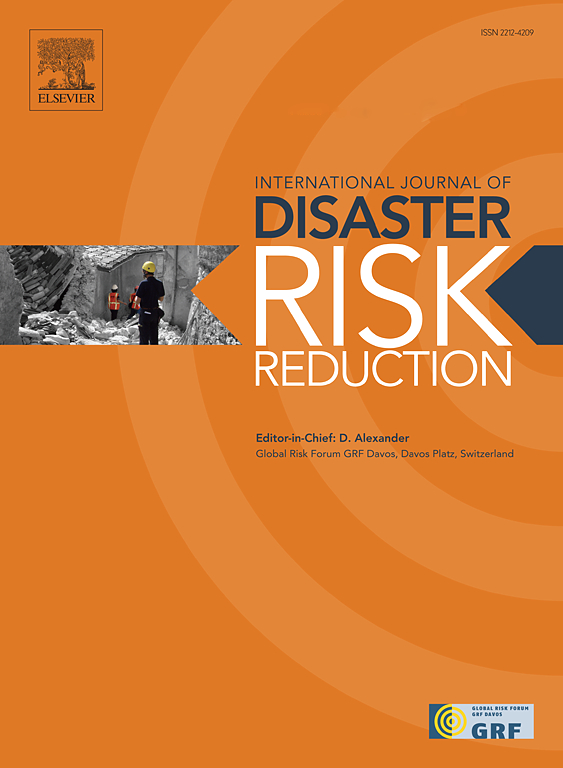A multi-step framework for measuring post-earthquake recovery: Integrating essential infrastructure System's serviceability in building functionality
IF 4.2
1区 地球科学
Q1 GEOSCIENCES, MULTIDISCIPLINARY
International journal of disaster risk reduction
Pub Date : 2024-11-01
DOI:10.1016/j.ijdrr.2024.104929
引用次数: 0
Abstract
Measuring and predicting the functionality of buildings is a core aspect of community resilience analysis, which is jointly dependent on structural integrity and essential services provided by critical infrastructure systems. A functional building is one that is used for its intended services. This paper develops a multi-step community-level functionality analysis framework by modelling: (1) building functionality that integrates the building's structural performance, essential water and electric power service performance, and physical accessibility through road networks; (2) portfolio-level building recovery by aggregating functionality of buildings for an entire community; and (3) serviceability of infrastructure systems. Graph theory is applied to assess performance of infrastructure systems. The cascading effect of water pipe failure on the road network is modelled through geographic dependency analysis. Post-earthquake water demand changes due to household dislocation and return, and increased water service demand at essential facilities are captured to model the performance of the water network under stressed conditions. The framework also assesses household-level housing recovery and integrates results with physical damage repair to more holistically depict the functional recovery of buildings from the perspective that buildings must be occupied to be fully functional. The proposed framework is illustrated for a scenario earthquake for the virtual community of Centerville. Findings provide an up-to-date measurement of post-disaster functionality for buildings and critical infrastructure systems that can guide decision-makers during pre-disaster planning and post-disaster recovery. The example demonstrates that consideration of essential infrastructure services significantly alters the functionality of the built environment during the recovery process. For instance, power outages resulted in functionality loss of up to 75 % of physically operable buildings for as much as 14 days. Consideration of physical accessibility loss to nearest road segments resulted in a portfolio functionality drop of up to 9 % for 6 days, and partial water shortage significantly hampered the functionality of the impacted area, including the regional hospital. Approximately 3 % of households were unable to repair their damaged homes and became homeless. The proposed framework enables risk-informed decisions regarding long-term recovery at the community scale with inclusion of those living at the margins and most susceptible to long-term negative consequences from disasters.
衡量震后恢复的多步骤框架:将基本基础设施系统的可用性纳入建筑物功能中
测量和预测建筑物的功能性是社区复原力分析的一个核心方面,而社区复原力分析则共同依赖于关键基础设施系统提供的结构完整性和基本服务。功能性建筑是指可用于其预期服务的建筑。本文开发了一个多步骤的社区级功能分析框架,建模方法包括:(1) 建筑物功能,综合建筑物的结构性能、基本水电服务性能以及通过道路网络的物理可达性;(2) 组合级建筑物恢复,综合整个社区建筑物的功能;(3) 基础设施系统的可服务性。图论适用于评估基础设施系统的性能。通过地理依赖性分析,模拟了水管故障对道路网络的连带影响。地震后,由于住户搬迁和返回造成的用水需求变化,以及基本设施用水服务需求的增加,都被纳入了模型中,以模拟供水网络在压力条件下的性能。该框架还评估了家庭层面的住房恢复情况,并将结果与物理损坏修复相结合,从建筑物必须有人居住才能充分发挥功能的角度,更全面地描述了建筑物的功能恢复情况。建议的框架针对森特维尔虚拟社区的地震场景进行了说明。研究结果提供了建筑物和关键基础设施系统灾后功能的最新测量方法,可在灾前规划和灾后恢复期间为决策者提供指导。该实例表明,在灾后恢复过程中,对重要基础设施服务的考虑会极大地改变建筑环境的功能。例如,停电导致多达 75% 的可实际操作的建筑物功能丧失长达 14 天。考虑到最近路段的实际可达性损失,组合功能下降达 9%,持续 6 天,部分缺水严重影响了包括地区医院在内的受影响地区的功能。约 3% 的家庭无法修复受损房屋,无家可归。所提议的框架能够在社区范围内就长期恢复做出风险知情决策,并将那些生活在边缘、最容易受到灾害长期负面影响的人纳入其中。
本文章由计算机程序翻译,如有差异,请以英文原文为准。
求助全文
约1分钟内获得全文
求助全文
来源期刊

International journal of disaster risk reduction
GEOSCIENCES, MULTIDISCIPLINARYMETEOROLOGY-METEOROLOGY & ATMOSPHERIC SCIENCES
CiteScore
8.70
自引率
18.00%
发文量
688
审稿时长
79 days
期刊介绍:
The International Journal of Disaster Risk Reduction (IJDRR) is the journal for researchers, policymakers and practitioners across diverse disciplines: earth sciences and their implications; environmental sciences; engineering; urban studies; geography; and the social sciences. IJDRR publishes fundamental and applied research, critical reviews, policy papers and case studies with a particular focus on multi-disciplinary research that aims to reduce the impact of natural, technological, social and intentional disasters. IJDRR stimulates exchange of ideas and knowledge transfer on disaster research, mitigation, adaptation, prevention and risk reduction at all geographical scales: local, national and international.
Key topics:-
-multifaceted disaster and cascading disasters
-the development of disaster risk reduction strategies and techniques
-discussion and development of effective warning and educational systems for risk management at all levels
-disasters associated with climate change
-vulnerability analysis and vulnerability trends
-emerging risks
-resilience against disasters.
The journal particularly encourages papers that approach risk from a multi-disciplinary perspective.
 求助内容:
求助内容: 应助结果提醒方式:
应助结果提醒方式:


